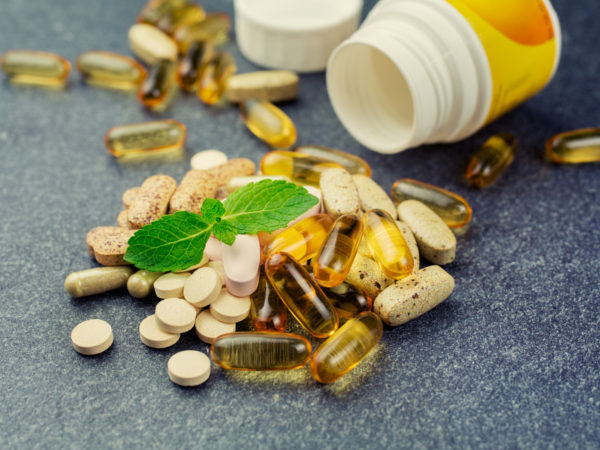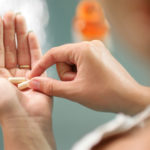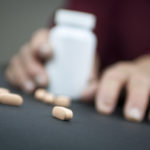Supplements For Living Well

If you take supplements, vitamins or herbs, the following information can help.
Herbalism and Herbal Supplements
Supplements: Antioxidants
Four Simple Steps to Taking Your Supplements
Supplements for Strong Bones
Vitamin E for Heart Disease
Wondering About Flower Remedies?
Herbalism and Herbal Supplements
Herbalism (herbal medicine) is a healing method that has been used throughout the world since ancient times. Plants and plant derivatives have been used for centuries to treat numerous illnesses and to assist bodily functions. While herbalism is not a licensed profession in the United States, herbs are often recommended by healthcare practitioners as a practical way to address a variety of medical conditions.
Before you begin using herbal remedies, make sure you know and understand what you are taking. The following can help guide you through your research and purchase of herbal remedies:
- Educate yourself. Check out unbiased information sources such as The Encyclopedia of Popular Herbs by Robert McCaleb et al., or the American Botanical Council Web site, herbalgram.org.
- Use standardized extracts. These come in liquid or solid forms, and contain a specified amount of an herb’s compounds.
- Look for certification. The United States Pharmacopeia, NSF International, and the UNPA offer a measure of quality assurance regarding a product’s ingredients and dosages.
- Read labels. Keep an eye out for the expiration date and dosage amount.
- Use reputable brands. Well-known brands tend to use higher standards for their handling, packaging and ingredients.
You should also follow some precautions before taking an herbal remedy. Some general guidelines include:
- Be aware of herb/drug interactions. Herbs and drugs that have similar purposes (such as sedatives, blood thinners, or stimulants) should not be taken together, nor should herbs and drugs with opposite actions (a sedative herb taken with a stimulant drug, for instance). Ask your local pharmacist about any known adverse reactions, or check out the book Herb Contraindications and Drug Interactions, third edition, by Francis Brinker, ND.
- Communicate with your physician. It is important to tell your doctor of any herbs you are taking, especially before surgery. Blood-thinning, sedative, and stimulant herbs may have adverse effects on surgery and subsequent recovery. Some herbs may interfere with prescribed medications, as well. Be sure to disclose any herbs or supplements you are currently taking if a new medication is prescribed.
- Avoid taking herbs while pregnant or breastfeeding. There are some exceptions, such as ginger in capsule or candied form and chamomile tea. Always consult your obstetrician for more information to avoid possible complications.
Supplements: Antioxidants
When it comes to obtaining the micronutrients your body needs, the best possible source is food. But circumstances may prevent you from eating optimally every day. If this is the case, supplements can help as insurance against gaps in your diet. Antioxidants are especially important: they have been shown to safeguard the immune system, which is critical in times of stress; as well as benefit the heart, eyes, muscles and skin. Antioxidants can also slow the effects of aging, and help block the chemical reactions that generate free radicals – harmful compounds that damage DNA.
The daily antioxidants Dr. Weil recommends are as follows:
- Vitamin C: 200 to 500 mg (divided into two doses) per day. Vitamin C is water soluble and anything not used by the body quickly passes out. Consider higher dosages if you are under extra stress, living in smoke filled or polluted environments, or not getting at least five servings of fruits and vegetables as part of your daily diet.
- Vitamin E: 400 IUs of mixed natural tocopherols (or at least 80 mg of mixed tocopherols and tocotrienols) a day. Since vitamin E is fat soluble, it must be taken with food to be absorbed. Also, choose natural forms of vitamin E (d-alpha tocopherol with mixed tocopherols, or better yet, mixed tocopherols and tocotrienols) instead of the synthetic form (dl-alpha-tocopherol). I take vitamin E at lunch or dinner.
- Selenium: 200 micrograms a day. Selenium is a trace mineral with antioxidant and anticancer properties. Selenium and vitamin E facilitate each other’s absorption, so take them together. Vitamin C may interfere with the absorption of inorganic forms of selenium (sodium selenite), so take the yeast-bound form instead. Doses of selenium above 400 micrograms a day may not be healthy.
- Mixed carotenes: 15,000 IUs a day. I recommend a natural form, which is easily found in health food stores. Read the label to make sure it gives you lycopene, the red pigment in tomatoes that helps prevent prostate cancer, and lutein, which protects against cataracts and macular degeneration. I take mine at breakfast.
Four Simple Steps to Taking Your Supplements
If you take supplements, vitamins or herbs, the following can help to lessen or prevent any side effects – and help to promote the benefits vitamins can provide:
- Take your supplements during or after a meal, unless directed otherwise, and drink plenty of fluids as well.
- Take consistently to achieve maximum health benefits. It usually takes two to three months before you feel the full positive effects of adding nutritional supplements.
- Take as indicated. Your supplements may be recommended or packaged for morning, noon or evening dosages, based on your individual health needs. For maximum benefit, take your supplements at the time of day indicated on the package.
- Keep your physician informed. Discuss any symptoms or health concerns with your physician, and inform them that you are taking dietary supplements.
Supplements for Strong Bones
Calcium and vitamin D are important nutrients for healthy bones. Calcium helps build bone mass and slow bone loss; vitamin D helps the body properly absorb calcium. You can get both these critical nutrients through supplements daily: women should aim for 500 to 700 mg per day of calcium from supplements and 2,000 IU of vitamin D; men should limit their calcium intake to 500 to 600 mg from all sources and aim for 2,000 IU of vitamin D. Or, better yet, increase your consumption of calcium and vitamin D-rich foods:
- Calcium: eat more dairy foods, dark leafy greens such as kale and collards, broccoli, canned salmon with bones, sardines, and dried figs. Also look for calcium-fortified foods such as soy milk and cereals.
- Vitamin D: get more oily fish (wild Alaskan salmon or sardines are good choices), fortified soy milk, orange juice and cereals into your diet.
Vitamin E for Heart Disease
Large studies have shown that vitamin E supplementation can lower the risk of heart disease in healthy adults by about 40 percent. Since clinical trials on people who already have heart disease have not been as promising, vitamin E may be better used as a preventive measure in those without existing cardiovascular problems. It works in part by reducing the oxidation of LDL (“bad”) cholesterol, inhibiting the formation of plaque in the arteries. It also helps prevent blood clots and may dampen inflammation. If you are interested in taking vitamin E to help prevent heart disease, try taking at least 80 mg of natural mixed tocopherols and mixed tocotrienols daily.
Wondering About Flower Remedies?
Physician Edward Bach introduced Bach flower remedies to England in the 1930s. He theorized that people fell into seven groups, based on their reactions to illness. The groups are fear, uncertainty, loneliness, over-sensitivity, lack of interest in present circumstances, despondency and over-concern for others. Learn more about Bach flower remedies.
He determined that to treat illness, one had to address patients’ emotional and mental states, and following the principles of homeopathy, he devised the flower essences for that purpose. Today, many homeopaths, naturopaths, chiropractors and herbalists still utilize flower essences in their practices with good success. Several brands of flower essences are sold at health food stores for self-care, but you’ll need to determine on your own which particular emotional state you’re trying to treat.









